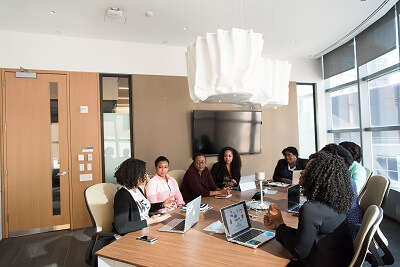Arranging a meeting may seem like a straightforward process, but in our fast-paced economy that now juggles in-person, hybrid, and remote positions, coordinating schedules and meeting times can be critical to maximizing meeting effectiveness and overall efficiency.

Whether you’re a seasoned CEO or a new hire, being aware of how to hold effective meetings can help to maximize everyone’s productivity so that you get the most out of your meetings when you have them.
To make your sessions as efficient as possible, you should invite a maximum of 5-8 people for internal meetings and 2-3 people for appointments with customers. Make sure each participant can move the discussion forward.
Aim for 5-8 Persons
The recommended size for a business meeting is 5-8 people. [1]
This quantity maximizes efficiency because it incorporates the critical personnel responsible for contributing to any protocols and projects being discussed while allowing everyone to have maximum input in the discussion.
Further, having fewer people at a meeting, especially those who are essential to any project or changes being considered, reduces the efficiency of having uninvolved personnel sitting idle, or even being bored, during the meeting while also ensuring that everyone present in the meeting can contribute with minimal interruptions.
With fewer invitees to a meeting, the meeting itself is easier to schedule and organize, since fewer schedules need to be aligned and the meeting can concentrate on the roles of those in attendance.
Most importantly, with fewer people in attendance, discussions can be more in-depth and honest rather than discouraging sharing that quite often occurs in larger groups.
Establish the Meeting’s Parameters
Before any meeting commences, whoever is arranging the meeting needs to be responsible for charting an agenda for the meeting.
This may be the responsibility of a project manager, communications director, or anyone responsible for overseeing the majority of the personnel for a specific project or for coordinating the project itself. A quality agenda should incorporate some basic frameworks to maximize efficiency.
First, the meeting needs to have a clear purpose. This purpose is often oriented on directing attention to the results of the specific project, but can also incorporate check-ins and quality assurance parameters that may be routine or project-specific if a project has just begun or is still underway.
It may sound simple, but it’s also important to establish a clear time frame for the meeting.
Knowing how long the meeting will last will allow all important topics to be discussed by appropriate personnel while also allowing room for discussion.
It’s also important to identify what specific topics need to be discussed during the meeting in case the conversation gets off track. Writing these topics on a whiteboard, poster board, or in a PowerPoint ensures that all meeting participants are aware of the meeting’s goals in case the meeting veers off track.
Once a time frame has been established and time is allotted for each topic, identifying how each topic will be addressed will also maximize meeting efficiency. Some issues may need to be discussed at the group level, while other issues may serve as reminders for specific personnel or even feature smaller groups to discuss within a meeting.
Creating the Agenda
Developing a clear and concise meeting agenda is crucial to ensuring that your meetings are effective and efficient. The agenda serves as a roadmap for the meeting, outlining objectives, discussion topics, and desired outcomes.
When deciding whom to invite, it’s important to consider the agenda and select individuals with relevant expertise who can contribute to problem-solving and address sensitive information, if applicable.
Additionally, consider organizing breakout groups with subject matter experts to dive deeper into specific topics. By thoughtfully crafting the agenda and selecting the appropriate attendees, you can ensure that your meeting is productive and accomplishes its goals.
Determine the Exact People
Once a meeting agenda has been established, it’s time to identify who specifically should attend your meeting. Who will attend will depend on what this meeting pertains to. [2]
For example, meetings should be arranged with employees to discuss project developments or even company developments, while arranging a meeting for managers or other higher-level personnel will more pertain to company operations or any personnel changes that need to be made.
There may also be instances where specific clients or regulatory agencies and associated personnel may choose to conduct a meeting, whether for interest in a specific project or service or simply to resolve any concerns or issues. In general, and in keeping with the above guidance, it’s most important to invite only those people who are directly affected.
1. Meeting with Employees
In a meeting with employees, inviting only the personnel working or managing a specific project helps to keep the meeting focused; where meetings are more company-wide, repeat meetings with smaller sections of personnel (for larger companies) can help to make the meeting more inclusive; larger meetings are better for general broadcasts of policies or directives.
2. Higher-Level Personnel
Similar guidelines apply to meetings with higher-level personnel or colleagues, where those who are most relevant to a specific department or related agency should be involved in the meeting.
3. Meeting with a Client
When meeting with a client, limit the meeting to the client and one or two representatives, while matching the client’s contribution with appropriate company personnel. It’s always a good idea to incorporate someone to record any important conversations for future reference and to remind everyone after the meeting about important topics discussed.
Identify Business Meeting Objectives
It’s crucial to establish clear business meeting objectives to determine the appropriate attendees and avoid wasting valuable time. Before scheduling meetings, it’s important to identify the specific goals you hope to achieve and conduct a reality check to assess the feasibility of the objectives.
Decision-making should also be considered when determining who to invite to the whole meeting. For instance, if the objective is to make a critical decision, it’s essential to ensure that all decision-makers and relevant subject matter experts are in attendance.
By keeping these factors in mind when deciding whom to invite, you can ensure that meetings are focused, productive, and successful in achieving their intended outcomes.
Making a Meeting Maximally Efficient
Once the meeting has been arranged and the appropriate personnel has been invited, it’s important to follow some meeting etiquette guidelines to maximize efficiency.
Sending a reminder a day or two before the meeting will help to ensure that everyone is on time and prepared for the meeting. This reminder can also serve as a guideline for what to expect and what to bring to the meeting.
Depending on the meeting’s length, ensuring that proper materials ranging from office supplies to food are important to keep the meeting fluid and productive. It’s also imperative that any essential supplies and equipment are arranged and tested before the meeting and that the appropriate room has been selected and reserved to maximize space while also making conversation conducive.
For formal meetings, particularly with new clients, colleagues, or employees, creating seating arrangements can simplify the entrance and discussion process while also facilitating discussion between related or integrated units or parties.
Maximizing meeting efficiency doesn’t need to be an overblown and tedious affair. Whether relating to the number of people invited, who to invite and what to talk about, arranging an effective meeting simply requires sticking to the points illuminated above. With a few simple guidelines, you can ensure that you invite the right people each time you hold a meeting and that everyone is prepared to make the most of this opportunity.
Sources:
[1]: https://hbr.org/2018/06/the-most-productive-meetings-have-fewer-than-8-people
[2]: https://smallbusiness.chron.com/etiquette-business-meeting-invitations-2917.html

Katie Holmes is a senior author at everyday-courtesy.com with over 15 years of experience in marketing and psychology. As a freelance consultant, she also supports companies and executives in overcoming communication challenges. Katie is a passionate digital nomad working on her first book on the art of communication.

